In April 1995, the world was captivated by the release of the breathtaking image known as the ‘Pillars of Creation’. This iconic image, taken by the Hubble Space Telescope, showcased the beauty and wonder of the Eagle Nebula. Fast forward to today, and the James Webb Telescope is taking center stage in revealing even more secrets of this celestial wonder.
The Collaboration of Two Telescopes
While the James Webb Telescope initially captured images of the Eagle Nebula, it wasn’t until the data from both Hubble and Webb were combined that a new dimension was added to our understanding of this cosmic masterpiece. Astronomers have now created a stunning 3D animation that takes viewers on a mesmerizing journey through the pillars of creation, providing a deeper insight into their structure and formation.
The Pillars of Creation are predominantly composed of molecular hydrogen and dust, shaped by the powerful forces of wind and radiation from nearby young stars. These cosmic pillars, resembling fingers reaching out into the universe, harbor young hot stars within their protrusions, some of which are larger than our entire solar system. The tallest pillar extends a staggering three light-years from top to bottom, showcasing the vastness and complexity of these structures.
Astronomical Discoveries Through Visualization
The recent 3D animation, based on real observational data led by Anna McLeod of the University of Durham, not only provides a visual treat but also offers valuable insights into the collaboration between Hubble and Webb. While Hubble captures objects glowing in visible light at high temperatures, Webb’s infrared camera reveals cooler objects and hidden stars within the dust clouds. This collaborative effort enhances our ability to study various stages of star formation, from protostars to newborn stars, shedding light on the intricate processes at play in the cosmos.
One of the most exciting outcomes of this new visualization is the creation of a 3D printable model of the Pillars of Creation. By converting the data into an STL file format, individuals can now download and print their own 3D model of this cosmic marvel using a 3D printer. This not only caters to enthusiasts and astronomy buffs but also serves as a valuable educational tool for schools, allowing students to explore the wonders of the universe in a tangible and engaging way.
The collaborative efforts of the Hubble and James Webb Telescopes have unlocked a new dimension of understanding and appreciation for the Pillars of Creation. Through stunning visuals and innovative technologies, we continue to unravel the mysteries of the cosmos, inspiring awe and curiosity in both the scientific community and the general public.


Leave a Reply